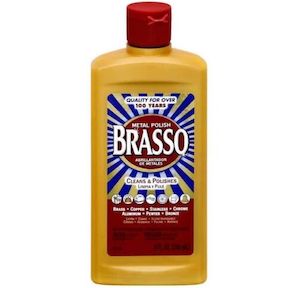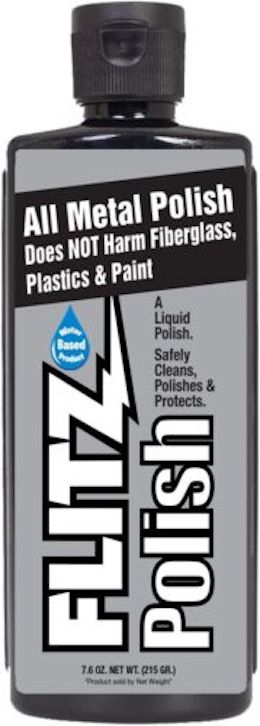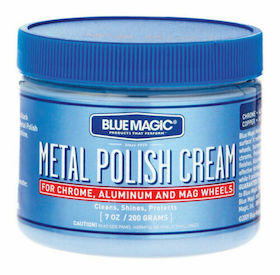
Curated with aloha by
Ted Mooney, P.E. RET

The authoritative public forum
for Metal Finishing 1989-2025

-----
Polishing Old Copper Fire Extinguishers, p.2
< Prev. page (You're on the last page of the thread)
Q. The inside where the bottle is supported is highly discolored and appears to be corroding. How do I clean this? Thank you.
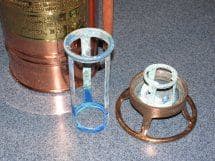
Retired - Redding, California
May 31, 2010
A. I have polished "many" brass extinguishers over the past several years. The conditions ranged from minor to severe. I've used Brasso
⇦ this on
eBay
or
Amazon [affil links] on the easy ones but for the severe cases believe it or not use Lysol Toilet Bowel cleaner. Step one- You pour the cleaner onto soft brass wool
⇦ this on
eBay or
Amazon [affil links]
or fine grade 00 steel wool
⇦ this on
eBay or
Amazon [affil links] and begin to buff lightly until the color returns. The copper will turn a "salmon" color. Step two, use a buffing wheel and a product called Tripoli (Ace Hardware) brown tripoli buffing compound
⇦ this on
eBay
or
Amazon [affil links]
. Finally step 3 I use a product called Flitz ⇦[this on
eBay or
Amazon affil links]
to complete the polishing process. You can also use Brasso
⇦ this on
eBay
or
Amazon [affil links] . The very final step is to seal it with a clear gloss finish. A few coats are sufficient. I have taken a $15.00 extinguisher and sold it for up to $150.00
I have also placed the extinguisher in a PVC pipe ... fill the pipe with water until it covers the extinguisher then remove the extinguisher. Add the Lysol, stir and replace the extinguisher. Let it sit for several hours or more and remove it. It should be a salmon color. Then follow the above steps (two and three) . Here are before and after pics. Good Luck!
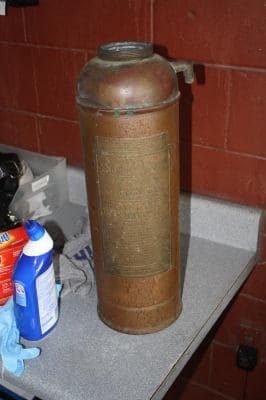

- Deltona Florida
December 12, 2010
A. I am now a retired firefighter. One of my duties as a rookie was to polish brass on the fire equipment as well as the poles and extinguishers.
The best thing we found was Brasso, to clean the copper and brass, I also slightly remember about using a lemon juice on the copper. So maybe try these tricks and see if it helps, just don't yell "Movie" in a firehouse, gets everybody in a panic! :), firefighters don't like missing movies.
Some of the small extinguishers that have a push rod in the end are very dangerous if chemicals come out of them, they were primarily black and silver or black and gold, I don't remember the name of the chemical but it's not to be touched, inhaled absorbed , etc. -- so be careful; they are small about 12-16 inches in length and about as round as a soda can.
Thanks,
- Clyde, Texas USA
December 13, 2010
A. I do not recommend any of the brass polishes that are sold; they attack the copper and brass and leave red spots because brass is made of zinc and copper and this polish attacks the zinc and leaves red spots and please do not use vinegar, for it is an acidic base. I have been a professional polisher for over 35-40 years. I have hi-speed buffing machines with cotton buffing wheels that I have buffing compounds that are compatible to the brass and copper and is very clean. This is not a job for an amateur because you can get hurt. Once it is polished do not use this store bought lacquer that is sold by Walmart but a professional lacquer from Agate lacquer co; this lacquer is made for toughness and outdoor use it will give you years use of bright clean brass or copper without polishing. I hope I helped and saved you some disastrous results on such beautiful and collectible items. By the way if you ever find one with the Elkhart stag on the front grab it; it's worth over 200 apiece now. Thanks for letting me share.
wallace gainey- columbia, South Carolina united states
April 20, 2011
|
|
info: The glass DOES NOT BREAK... - Ventura California May 30, 2011 |
Q. I have a 1906 brass fire extinguisher with all its original tags still with it I just want to know if they are worth anything and if they do what would be a good price to sell it for thank you for your patience and help with this matter.
Jim Yaser- Millbrae, California, USA
July 18, 2011
A. Hi, Jim. We can't do estimates or appraisals on this free site or we'd be swamped under thousands of requests in very short order -- there are dozens of paid appraisal sites, and who would go to any of those dozens and pay for an appraisal if there were a free site offering the same service :-)
But try asking a local antique dealer for an evaluation, or start by simply seeing what people want for similar stuff on eBay
Antique Brass & Copper Fire Extinquishers on
eBay
affil links
Then if you're still not confident -- as mentioned -- there are lots of pay sites offering appraisals. Good luck!
Regards,

Ted Mooney, P.E.
Striving to live Aloha
finishing.com - Pine Beach, New Jersey
A. I'm really not sure why some of the postings describe such efforts to polish these copper extinguishers. I have collected a few of these in my time and simply use Brasso
⇦ this on
eBay
or
Amazon [affil links] and a roll of paper towels. Paper towels work well because of their very slight abrasive effect from the wood pulp. Cotton socks, etc, will also work but I have found not quite as well. It takes about an hour of work and they always come up really nice and shiny, except where they are dinged up or have scratches. It's not hard and I don't have to submerge it into any containers of weirdly named chemicals (Liver of sulfur? LOL).
Now some of them may be lacquered and those DO require a bit of work to remove the lacquer. Just some good quality paint stripper works fine for that, but if they are tarnished then they probably aren't lacquered anyway.
As I said, I have done several of these now, in their typically tarnished condition, and they all polish up very nicely. Just sit on your porch for an hour and get it done. Easy stuff. :)
- Seminole, Florida, USA
August 8, 2011
Ed. note: Liver of sulfur wasn't suggested as a polish, Jerry, but as a way to instantly re-darken an old fire extinguisher which the owner regretted polishing.
Q. Hi
I have vintage "The Homoh fire Extinguisher". I wish to ask who would be the best type of person/business to convert this into a table lamp. I appreciate your thoughts...Kindest of regards Jill
- United Kingdom
December 7, 2011
Q. I just bought an Elkhart extinguisher and I am having trouble removing the top of the canister. I tried to grease it with WD-40 to no avail. Does anyone have any suggestions? Thanks for your help :)
James Mancuso- Reading, Pennsylvania, USA
December 16, 2011
A. The Soda-Acid type water fire extinguishers were all made the same way, no matter what the brand was. A casing with hose and nozzle, usually the nozzle was the same material as the lid. Inside was a cast iron cage, and a glass bottle with a cork. When you got the extinguisher to where it would be stored, you removed the cork and put the lid on. The glass bottle was filled partially with sulfuric acid. The casing was filled with 2.5 gal of water/bicarbonate of soda mixture. Turning the fire extinguisher bottom up produced a gas-causing chemical reaction, neutralizing the acid, and pushing the water out. This was how "chemical fire trucks" worked, too, but on a larger scale. Many large, wheeled, industrial fire extinguishers were the same way, but they were mixed when the need to use them arose. They were messy, dangerous and ruined a lot of stuff.
I grew up in a family where we had a lot of men who were volunteers in the 20's-60's. Then I got back into it in the late 90's. At one point, I had about two dozen different extinguishers. My grandfather, a fireman and ambulance driver in the 50's and 60's kept three of these in active use. Stored, ready, and charged until about five years ago when one was knocked over. You know what happens when they sit too long, filled with water? They corrode inside. The elbow to the nozzle got plugged with chunks of blue-green material, it hissed for a few minutes after being tossed behind the barn to vent...and exploded, violently. Took the paint off an old car, and the barn alike. The yard died, and the ground was blue-green till it rained. I would suggest cleaning it up, and putting it on the wall. I would NOT suggest trying to charge it. Get a pressurized water extinguisher you can fill with a tire pump, if you like to play.
- Dushore, Pennsylvania USA
December 20, 2011
Q. Hello to all,
I have two Fyr Fyter soda/acid extinguishers and trying to restore. Two things I am dealing with, and one is the removal of the brass cap. It is stuck and if anybody can offer good ideas how to unscrew it, please let me know. Item two, does anybody know any parts replacement web site for the hose/nozzle? I need two of them.
Thanks, Vic
amateur restorer - Fletcher, North Carolina
February 9, 2012
A. I have restored numerous fire extinguishers and have found that a long piece of thick/stout wood that fits through the lid rings is a safe way to get the lid off. If you can find a piece that is just small enough to barely fit into the rings on the lid you can put a pipe on the wood as leverage or use a hammer to tap the wood. the wood does not damage the lid. hope this helps
Noel Macarthur- Shelby, North Carolina
April 3, 2012
Q. I recently purchased a Red Star Model 303 fire extinguisher at a garage sale. At some point someone painted it red. You can see the tarnished copper around the top where the paint has rubbed off. I would like to strip and polish it, but was concerned about de-valuing it if I did. Is it better to leave it as is or restore it as it would have been new?
Rob Ellis- Bend, Oregon, USA
May 17, 2012
A. I have been in the firefighting equipment business for 41 years (and still am today). The Soda / Acid fire extinguishers were filled with approximately 2.5 gallons of Water with dissolved Sodium Bicarbonate. We filled thousands of them back in the day ...we mixed batches in 55 gallon drums of warm water with 2 propellers on a shaft attached to a motor to mix the 40 pounds of Baking Soda slowly dumped in the drum. It mixed for at least 15 minutes or more. Then there was a glass bottle approx. 3 inch diameter by 6" tall "half" filled with 66 degree Sulfuric Acid (very, very nasty stuff). The clear glass acid bottle had a narrowed neck. In the top was a "lead" stopple or stopper. It was about 1.5" tall with a flat bottom... kinda looked like a mushroom. It loosely sat on top of the glass bottle. The extinguisher hung on the wall this way...but when needed, the user would invert the fire extinguisher, allowing the stopple to come out and the Sulfuric acid mixed with the Soda Water and a chemical reaction occurred creating carbon dioxide (and who knows what else) gas to be generated "pressurizing" the cylinder and pushing the diluted soda water onto the fire. Note that Soda Acid fire extinguishers were for class A ordinary combustibles like paper, trash, wood, anything that leaves an ash. They had to be emptied and refilled with fresh Soda Water and Sulfuric Acid every year. They came in Brass, Copper, and eventually Stainless Steel. I believe the Stainless Steel units were last sold in 1969.
They were prone to burst because spiders and wasps would plug up the nozzle tip and when used on a fire, the nozzle tip would not let the agent to escape and the cylinder had no way to relieve the pressure generated, so it would burst. Many people were hurt over the years. Kids in school would jam their pencils in the end of the nozzle and break it off. Same result...the tank would rupture.
Anyway, the easiest way to remove the cap is to get a pipe, or bar, or long wrench or breaker bar and put in the top cap crossways. Assuming the tank is empty of any contents, stand over the top of the extinguisher and hold the tank with your two feet squeezing the tank. Bang the wrench in a counter clockwise motion until it comes loose. If it is tough to get off, try penetrating oil. Be persistent...give the penetrating oil to do its job... It should eventually come off. Be sure to rinse the inside with cool or cold water several times to be safe. Wear protective gear ...
To clean...that's a tough one if you are not familiar with the properties of some acids. If the extinguisher is down to bare metal...great! If not...you have some work ahead of you. I have used both sulfuric acid and muriatic acid on the outside of the tank to cut through the black / brown ugly lacquer. It takes several coats to do it. I put one extinguisher in one 5 gallon bucket. First, do this somewhere that has great positive ventilation...the fumes are bad for you! I would slowly, precisely, and gently pour the acid directly on the extinguisher, allow the thick syrup-like acid to run down the sides into the bottom of the bucket. Then I would slowly and gently move the extinguisher to another clean 5 gallon bucket and gently repeat the process, each time trying to cover areas not yet touched by the acid. The extinguisher will foam a little and turn kind of pinkish. That's good! When finished dispose of the acid mixture properly... Remember this stuff is really, really, really bad stuff. It will eat a shirt, or pants, or rags up in a matter of minutes! No kidding!! Next rinse the acid /crud off the extinguisher WITH SLIGHTLY COOL WATER. NOT COLD, NOT WARM, AND DEFINITELY NOT HOT WATER. Warm or hot water will stain the brass / copper. Not good. Use slightly cool water. Then wash extinguishers with any gentle dish washing liquid and slightly cool water and a soft brush. Right side up, upside down, on it's side, on it's other side. Then when you think it is acid free...rinse, rinse, rinse with slightly cool water. Let dry... use a soft cloth or whatever you have. Folks, this is only one way to do this....don't do this unless you can dress appropriately with all necessary PPE... Acid is a very unforgiving agent.
Now for the rewarding part. Go to a gun store, or to a sporting goods store, or order on-line some Simichrome
⇦ this on
eBay or
Amazon [affil links]
polish... Great stuff,,,better than any of the products I have ever used...and I have used them ALL! Rub with a soft cloth in a circular motion 4" square sections at a time. Let dry to a haze and then buff. Caution: the rag and Simichrome will turn black...don't be alarmed! It is supposed to do that. When done you may wish to clear coat it to keeping the air and moisture to get to it and make it lose it's luster and shine. Worse thing, you will have to polish it again with the Simichrome. Enjoy. Be safe.
Firefighting Equipment - Indianapolis, Indiana, USA
September 5, 2012
A. Hello fellow restoration fans. Me and my partner Jonathan did a small web episode on restoring a brass and copper Pyrene Soda/Acid fire extinguisher. In the video is a walkthrough of the process that we used to get an extremely nice finish.
Hope this helps!
Davis Hack
- Traverse City, Michigan, United States
January 8, 2013
August 31, 2014
A. I've been in the marine industry for many years; plus my dad had my a$$ polishing boat metal since I was a kid....from Boston Whalers to yachts. I noticed most boaters had Flitz on hand. Salt water can be cruel.
Flitz is the standard in my world. I'm not hanging around marinas that much anymore, or I just pay someone to clean my boat. However, I collect and polish antique nautical lights/fresnel lens and Flitz has never let me down even on some spots I thought would never come clean.
Takes a bit of elbow grease, patience, a $%#$ load of dremel tool buffers and 6 inch polishers.
It's cheaper then therapy!
-S
- Manchester, Tennessee, USA
Restoring old brass Toledo scale
Q. I have just purchased an old (1920 or earlier) Toledo Scale. It is Brass, but was sitting in an old garage for at least 15-20 years. It has a lot of old dirt, dust, grease etc. all over it. I was hoping to get some ideas on restoring this scale to a beautiful solid brass finish. Also any clean up ideas would be appreciated.
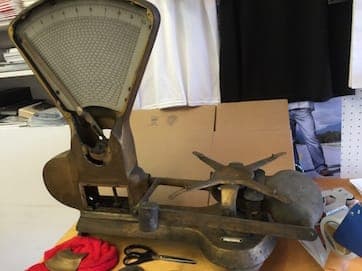
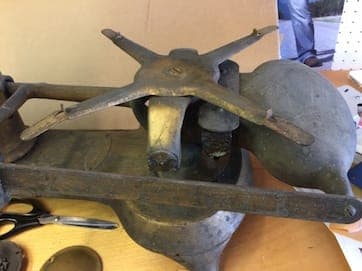
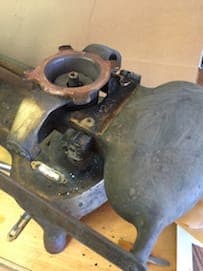
(click thumbnails for hi-rez pics)
Hobbyist - New Castle Pennsylvania USA
September 20, 2016
![]() Hi Pat. I imagine the procedures would be very similar to restoring old brass fire extinguishers, so we appended your question to a thread on that subject to get you started. Good luck.
Hi Pat. I imagine the procedures would be very similar to restoring old brass fire extinguishers, so we appended your question to a thread on that subject to get you started. Good luck.
Regards,

Ted Mooney, P.E. RET
Striving to live Aloha
finishing.com - Pine Beach, New Jersey
September 2016
A. There have been numerous threads here over the years on cleaning up/removing tarnish from various brass items. Brass beds seem to have been a popular one. We've seen a lot of good brass cleaning done with our citric acid based products. Obviously it depends a bit on what condition things are in to begin with. But if it were me, I would spend some time with non-hazardous cleaning materials before resorting to the more dangerous stuff.
"A lot of old dirt, dust, grease etc." should be cleanable by a good soak in hot soapy water I would think, maybe a good blasting with a garden hose or pressure washer. Once that's taken care of, citric or some other mild acid will likely get you at least most of the way to where you want to be.

Ray Kremer
Stellar Solutions, Inc.
McHenry, Illinois

September 21, 2016
A. Good day Pat.
Ray offers some good advice.
I would disassemble as many components as possible to clean parts in "hot soapy water", and polish them to remove any imperfections. Perhaps a local plating/polishing shop can assist with "restoring this scale to a beautiful solid brass finish."
Regards,
Aerotek Mfg. Ltd. - Whitby, Ontario, Canada
September 22, 2016
Q. I got a deal on Shiny Solid Brass cabinet pulls - I do not want it to darken but love the look of the brushed brass? Is it possible to just wire brush the knobs to get that look? Or Steel wool maybe? I haven't tried and I've looked everywhere for answers - Thanks
Etta Crouse- Fredonia, New York USA
January 26, 2018
A. Hi Etta. Yes, if they are solid brass there is no reason they can't be brush finished (if plated, the depth of the brush marks could easily be thicker than the plating though).
Brush finishing is probably more commonly and easily actually done with sandpaper than a wire brush.
Regards,

Ted Mooney, P.E. RET
Striving to live Aloha
finishing.com - Pine Beach, New Jersey
January 2018
A. I have 3 extinguishers that really looked rough when I got them. I bought some of the cheapest catsup I could find and smeared it all over them. Leave it on a few hours and wash it off. Then take fine steel wool and polish. It takes some elbow grease but looks nice in the end.
Ross knoll- Lakewales Florida usa
October 3, 2018
Q. I tried cleaning a WWII era fire extinguisher. There are spots that have nice color. I may have left the vinegar, salt, and flour solution on too long. There is a lot of pale to pink discoloration. How can I fix this? This thing has the potential to be beautiful.
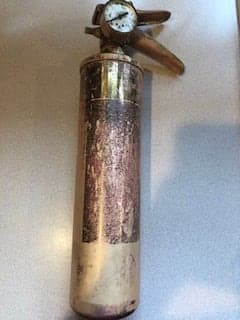
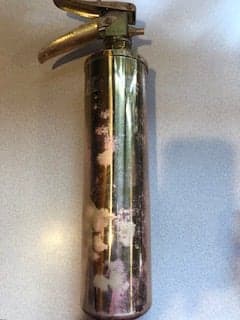
Matt Daugherty
- Cleveland, Ohio
March 13, 2019
A. I use a product from the parts store I think it's called Blue Magic
⇦ this on
eBay or
Amazon [affil links]
. It's with the metal polish. It's blue and works great on brass.
I have a lot of brass and it does not tarnish hardly at all. I've been using it for years.
- Canon, Georgia United States
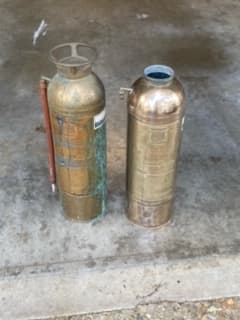
Q. I was given three old fire extinguishers I'm working to clean up. They seem to be stained by soda acid or something else. Any recommendations to clean them.
Phillip D.Hobbyist - North Little Rock, Arkansas
October 23, 2021
A. There are plenty of brass polishes in tubes or cans, typically a paste. This can all be done by hand with time and patience.
Hand drill with polishing wheel can also help.
Metal Refinisher - SAN BERNARDINO, California
Q, A, or Comment on THIS thread -or- Start a NEW Thread
